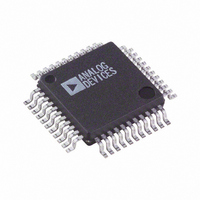AD7865AS-3 Analog Devices Inc, AD7865AS-3 Datasheet - Page 14

AD7865AS-3
Manufacturer Part Number
AD7865AS-3
Description
IC ADC 14BIT 4CH 5V 44-MQFP
Manufacturer
Analog Devices Inc
Specifications of AD7865AS-3
Rohs Status
RoHS non-compliant
Number Of Bits
14
Sampling Rate (per Second)
350k
Data Interface
Parallel
Number Of Converters
1
Power Dissipation (max)
160mW
Voltage Supply Source
Analog and Digital
Operating Temperature
-40°C ~ 85°C
Mounting Type
Surface Mount
Package / Case
44-MQFP, 44-PQFP
Available stocks
Company
Part Number
Manufacturer
Quantity
Price
Company:
Part Number:
AD7865AS-3
Manufacturer:
AD
Quantity:
1 831
Company:
Part Number:
AD7865AS-3
Manufacturer:
ADI
Quantity:
200
AD7865
Using an External Clock
With the H/S SEL and INT/EXT CLK pins tied to Logic 1, the
AD7865 will expect to be driven from an external clock. The
highest external clock frequency allowed is 5 MHz. This means
a conversion time of 3.2 s compared to 2.4 s using the inter-
nal clock. In some instances, however, it may be useful to use an
external clock when high throughput rates are not required. For
example, two or more AD7865s may be synchronized by using
the same external clock for all devices. In this way there is no
latency between output logic signals like EOC due to differences
in the frequency of the internal clock oscillators. Figure 10
shows how the various logic outputs are synchronized to the CLK
signal. The first falling edge of CLKIN must not occur until
200 ns after a conversion has been initiated (rising edge of
CONVST), at which point BUSY will go high. The AD7865
will then convert the analog input signal on the first selected
channel (see Selecting a Conversion Sequence) at a rate deter-
mined by the CLKIN. No external events will occur until the
14th falling edge of CLKIN. The data register output address
is then reset to point to Data Register 1 and FRSTDATA goes
high. This first conversion is complete on the 15th falling edge
of the CLKIN (indicated by EOC going low) and the result
from this conversion is loaded into Data Register 1. EOC goes
high again on the 16th falling edge of CLKIN. Figure 10 shows
a RD pulse occurring when EOC is low, enabling the conversion
result in Data Register 1 onto the data bus. The next 16 pulses
of CLKIN will convert the analog input signal on the second
selected channel and so on until all selected channels have been
converted. BUSY and EOC will go low on the 15th falling edge
of the last conversion sequence and EOC will return high on the
16th falling edge.
Standby Mode Operation
The AD7865 has a Standby Mode whereby the device can be
placed in a low current consumption mode (3 A typ). The
AD7865 is placed in standby by bringing the logic input STBY
low. The AD7865 can be powered up again for normal opera-
tion by bringing STBY logic high. The output data buffers are
still operational while the AD7865 is in standby. This means the
FRSTDATA
CONVST
BUSY
EOC
CLK
RD
t
18
2 3 4 5 6 7 8 9 10 11 12 13 14 15 16 1 2 3 4 5 6 7 8 9 10 11 12 13 14
FIRST CONVERSION
Figure 10. Using an External Clock
COMPLETE
–14–
user can still continue to access the conversion results while the
AD7865 is in standby. This feature can be used to reduce the
average power consumption in a system using low throughput
rates. To reduce the average power consumption the AD7865 can
be placed in standby at the end of each conversion sequence,
i.e., when BUSY goes low and taken out of standby again prior
to the start of the next conversion sequence. The time it takes
the AD7865 to come out of standby is called the “wake-up”
time. This wake-up time will limit the maximum throughput
rate at which the AD7865 can be operated when powering down
between conversions. The AD7865 will wake up in less than
1 s when using an external reference. When the internal refer-
ence is used, the wake-up time depends on the amount of time
the AD7865 spends in standby mode. For standby times of less
than 10 ms the AD7865 will wake up in less than 5 s (see Fig-
ure 11). For standby times greater than this some or all of the
charge on the external reference capacitor will have leaked away
and the wake-up time will be dependent on how long it takes to
recharge. For standby times less than one second the wake-up
time will be less than 1 ms. Even if the charge has been completely
depleted the wake-up time will typically be less than 10 ms.
Figure 11. Wake-Up Time vs. Standby Time Using the On-
Chip Reference
2.5
LAST CONVERSION
5
0
0
COMPLETE
2500
STANDBY TIME – s
15 16
5000
1
15
16
7500
10000
REV. A













